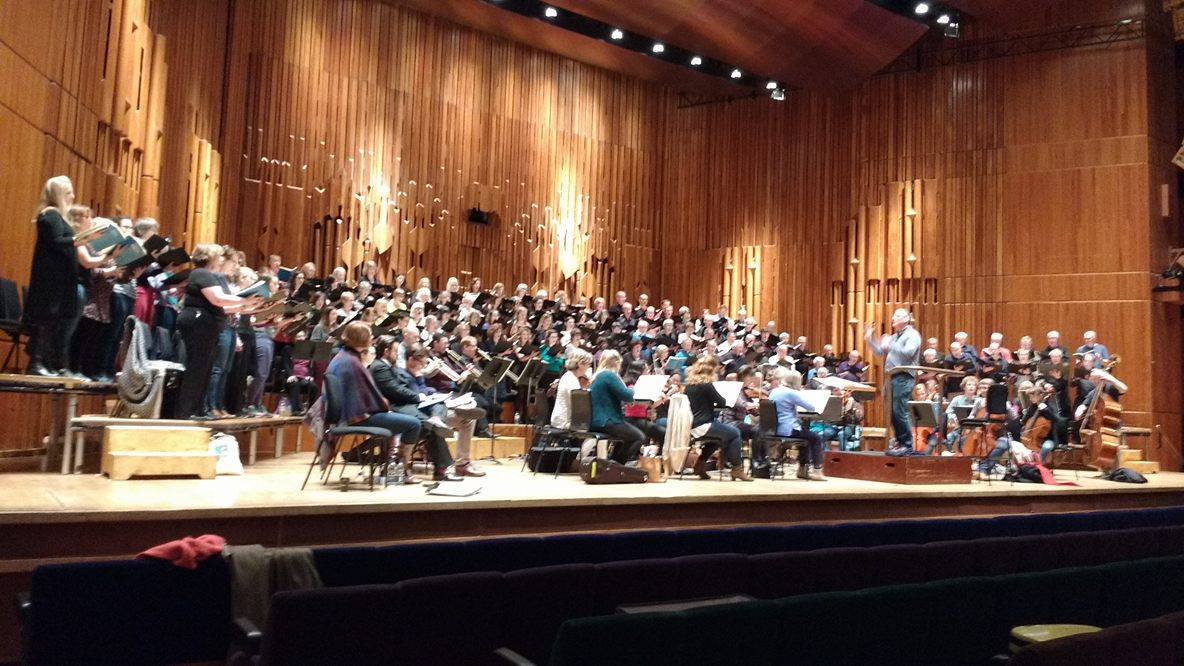By Mirianna la Grasta
Originally published on St John Street News: http://stjohnstreet.co.uk/how-david-temple-is-bringing-classical-music-bach-to-life/
“Cum Sancto Spiritu in gloria Dei Patris”: the public in the Hall seems to be astonished when the choir starts singing the 12th piece of Bach’s Mass in B minor (BWV 232). They are fully involved by the music, which is, in David Temple’s words, “exultant and joyful”. We are at Barbican Hall – Barbican Centre, London – and this is not a usual, modern, reproduction of Bach’s late baroque.
David Temple is the founder and conductor of Crouch End Festival Chorus – an amateur choir that works at professional levels – and, on this occasion, he is also conducting the Bach Camerata, a baroque chamber orchestra, for the second time. The peculiarity of this Mass is the pitch at which it is performed; in fact, the choir, the soloists and the Camerata are using the late baroque pitch, 415Hz, rather than the modern and standard one, which is 440Hz, a semitone higher. The Bach Camerata, being formed exclusively by baroque instruments, automatically reproduces the late baroque pitch, while, the soloists and the choir have to adapt to the orchestra’s tune.
It is important to understand that, in the first half of the 18th century, musical instruments had different features, were created with different materials and, as a consequence, they produced a different sound. As Sarah Butcher – cello player in the Bach Camerata – explains: “There are a lot of things that just happen because of the way the instruments are.” In cello, the baroque bow and strings are very different from the modern ones: as a matter of fact, playing a note, the sound will automatically decay and get quieter towards the end of the bow.
According to David Temple, performing this work as it would have been played in Bach’s time, means not only being academic, but, above all, making the music sound as it should sound. Temple continues, saying that he has been doing normal concerts, at 440Hz, for years and years, thinking that the early music specialists, who did it at 415Hz, “were just being academic”. When asked why he chose to become a convert to the baroque pitch, David says: “I think I went to hear a performance before I chose to do it myself, and when I heard that performance I was completely convinced that it was the right thing to do.”
During the rehearsal, Margaret Ellerby, soprano in the Crouch End Festival Chorus since the end of 1997, tells me that she has performed this Bach Mass before, but never in a late baroque pitch; she adds that “of course, at 415Hz, the music will sound different” and that she enjoys experimenting new ways of singing. Nevertheless, Margaret thinks that singing at a lower semitone “will not make a huge difference” for her.
On the other hand, Sarah Butcher, specifies that, as she plays both modern and baroque cellos, “it is quite hard” to switch from a pitch to another, “because the style of the playing is different, and so also the way you use the bow is quite different”.
When asked to describe Bach’s Mass in B minor with an adjective, David Temple describes it as “exultant”. He adds: “It goes straight to the heart and it is also the combination of Bach’s composing, it is like his greatest hits.” The Mass is one of the last pieces composed by Bach, between 1724 and 1749. The work is made of four parts, – 1.Missa, 2.Symbolum Nicenum, 3.Sanctus, 4.Osanna, Benedictus, Agnus Dei et Dona nobis pacem – which were dedicated to Frederick Augustus II, Elector of Saxony, when he became the King of Poland under the name of “Augustus III”. The great peculiarities of this Mass are two. First, in this piece Bach makes a parody of his greatest works; second, he gives a remarkable importance to the choir: as a matter of fact, the choir sings 17 pieces out of 26.
There are four key differences that David Temple highlights between the Mass played in baroque pitch and the one played at 440Hz. In detail, “The music lies beautifully within the voices of the singers in baroque pitch, where it feels kind of awkward when it is in a higher pitch.” Moreover, he compares the sound of the baroque flutes to the bird’s tweeting, explaining that, in the modern pitch, they do not have this “rustic” and “pastoral” quality. The trumpets as well are more appropriate, says Temple. And also the organ has a special tuning, which is different from the equal temperament. He concludes arguing that the Bach Camerata, playing with authentic instruments of the period, perfectly reproduces the late baroque pitch: “They have that sort of rustic quality to do it, they are more mellow, and the colours are softer and darker than in the modern instruments.”
Margaret Ellerby describes the Mass as “an amazing piece of music, something that you can listen to again and again, and you will always notice something different.”
Sarah Butcher uses three adjectives to define the piece: “thrilling”, “incredibly moving” and “majestic”.
During the rehearsal, both the performers argue that the public may not appreciate the different pitch, but will certainly like the new sound. “What I hope is that they listen to the music and they think that it just sounds amazing. I don’t really want them to notice this is a different pitch, I want them to enjoy and take it in,” says the conductor David Temple.
Back in Barbican Hall, the public rewards Temple with a sincere applause, standing up and feeling regenerated by the power of the baroque pitch. After nearly two hours of music, the audience cannot stop smiling and appreciating the soloists, the choir and the Camerata. People look at each other and comment positively on the concert: “it was great”, “it was absolutely overwhelming”, “I felt really involved by the music”, “it sounded amazing”, “that’s brilliant”.


Leave a comment